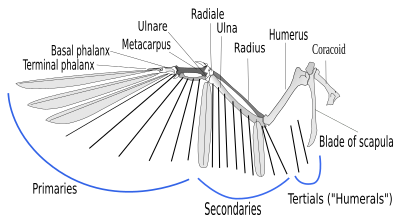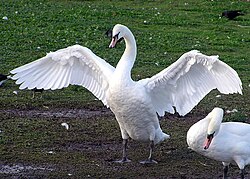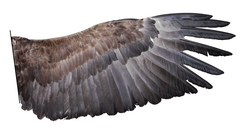Bird wings are a paired forelimb in birds. The wings give the birds the ability to fly, creating lift.



Terrestrial flightless birds have reduced wings or none at all (for example, moa). In aquatic flightless birds (penguins), wings can serve as flippers.[1]
Anatomy
editLike most other tetrapods, the forelimb of birds consists of the shoulder (with the humerus), the forearm (with the ulna and the radius), and the hand.
The hand of birds is substantially transformed: some of its bones have been reduced, and some others have merged with each other. Three bones of the metacarpus and part of the carpal bones merge into a carpometacarpus. The bones of three fingers are attached to it. The frontmost one bears an alula—a group of feathers that act like the slats of an airplane. Usually, this finger has one phalanx bone, the next has two, and the back has one (but some birds have one more phalanx on the first two fingers—the claw).
Finger identity problem
editThe bones of three fingers are preserved in the bird wing. The question of which fingers they are has been discussed for about 150 years, and an extensive literature is devoted to it.[2][3] The anatomical, paleontological, and molecular data suggests that these are fingers 1–3, but embryological data suggests that these are actually fingers 2–4.[1] Several hypotheses have been proposed to explain this discrepancy. Most likely, in birds, finger buds 2–4 began to follow the genetic program for the development of fingers 1–3.[3]
Wing shape
editThe shape of the wing is important in determining the flight capabilities of a bird. Different shapes correspond to different trade-offs between advantages such as speed, low energy use, and maneuverability.[4][5]
Two important parameters are the aspect ratio and wing loading. Aspect ratio is the ratio of wingspan to the mean of its chord (or the square of the wingspan divided by wing area). Wing loading is the ratio of weight to wing area.
Most kinds of bird wings can be grouped into four types, with some falling between two of these types. These types of wings are elliptical wings, high-speed wings, high aspect ratio wings and soaring wings with slots.
Elliptical wings
editElliptical wings are rounded and short. This type of wing allows for tight maneuvering in confined spaces such as dense vegetation. Elliptical wings are common in forest raptors (such as Accipiter hawks), and many passerines, particularly non-migratory ones (migratory species have longer wings). They are also common in species that use a rapid takeoff to evade predators, such as pheasants and partridges.
High speed wings
editHigh-speed wings are short, pointed wings that when combined with a heavy wing loading and rapid wingbeats provide an energetically expensive, but high-speed flight. This type of wing is present in fast-flying birds such as ducks. Birds that use their wings to "fly" underwater such as the auks also have small and elongated wings.
The peregrine falcon has the highest recorded dive speed of 242 mph (389 km/h). Peregrine falcons have relatively large wings but they partially close their wings during dives. The fastest straight, powered flight is the spine-tailed swift at 105 mph (170 km/h).
High aspect ratio wings
editHigh aspect ratio (elongated) wings confer high flight efficiency for flights of long duration. When combined with a low wing loading, they are used for slow flight. This may take the form of almost hovering (as used by kestrels, terns and nightjars) or in soaring and gliding flight, particularly the dynamic soaring used by seabirds, which takes advantage of wind speed variation at different altitudes (wind shear) above ocean waves to provide lift. Low-speed flight is also important for birds that plunge-dive for fish.
Soaring wings with deep slots
editThese wings are favored by larger species of inland birds, such as eagles, vultures, pelicans, and storks. The slots at the end of the wings, between the primaries, reduce the induced drag and wingtip vortices by "capturing" the energy in air flowing from the lower to upper wing surface at the tips,[6] whilst the shorter size of the wings aids in takeoff (high aspect ratio wings require a long taxi to get airborne).[6]
References
edit- ^ a b Vargas, A. O.; Fallon, J. F. (2005). "The Digits of the Wing of Birds Are 1, 2, and 3. A Review". Journal of Experimental Zoology Part B: Molecular and Developmental Evolution. 304 (3) (Journal of Experimental Zoology Part B: Molecular and Developmental Evolution ed.): 206–219. doi:10.1002/jez.b.21051. PMID 15880771.
- ^ Baumel, J. J. (1993). Handbook of Avian Anatomy: Nomina Anatomica Avium. Cambridge: Nuttall Ornithological Club. pp. 45–46, 128.
- ^ a b Young, R. L; Bever, G. S.; Wang, Z.; Wagner, G. P. (2011). "Identity of the avian wing digits: Problems resolved and unsolved". Developmental Dynamics. 240 (5) (Developmental Dynamics ed.): 1042–1053. doi:10.1002/dvdy.22595. PMID 21412936. S2CID 37372681.
- ^ Norberg, U. M. (1990). Vertebrate Flight : Mechanics, Physiology, Morphology, Ecology and Evolution. Berlin. ISBN 978-3-642-83848-4. OCLC 851392205.
{{cite book}}: CS1 maint: location missing publisher (link) - ^ Pennycuick, C. J. (2008). Modelling the flying bird. Amsterdam: Academic. ISBN 978-0-12-374299-5. OCLC 272383165.
- ^ a b Tucker, Vance (July 1993). "Gliding Birds: Reduction of Induced Drag by Wing Tip Slots Between the Primary Feathers". Journal of Experimental Biology. 180: 285–310. doi:10.1242/jeb.180.1.285.